Wine is one of the many additives that can be incorporated into soap to add benefits or improve the quality and feel of the final bar. It promotes a stable, rich, and luxurious lather due to its natural sugars and may also contain antioxidants and vitamins that can be beneficial to the skin.
Wine handmade soap makes a great gift for wine connoisseurs, as well.
Here I will be showing you one of the methods I use to create wine soap.
This is a bit more advanced soap-making as there is more preparation involved, so if this is your first time making soap, I would suggest starting with a simpler recipe to get a feel for the method of making cold process soap before using additives containing sugar and/or alcohol.
For this recipe, I used our local Trinidadian Correia’s Hard Wine. It is a special blend made with Bois Bande (Richeria grandis), Horny Goat Weed (Epimedium) and Siberian Ginseng.
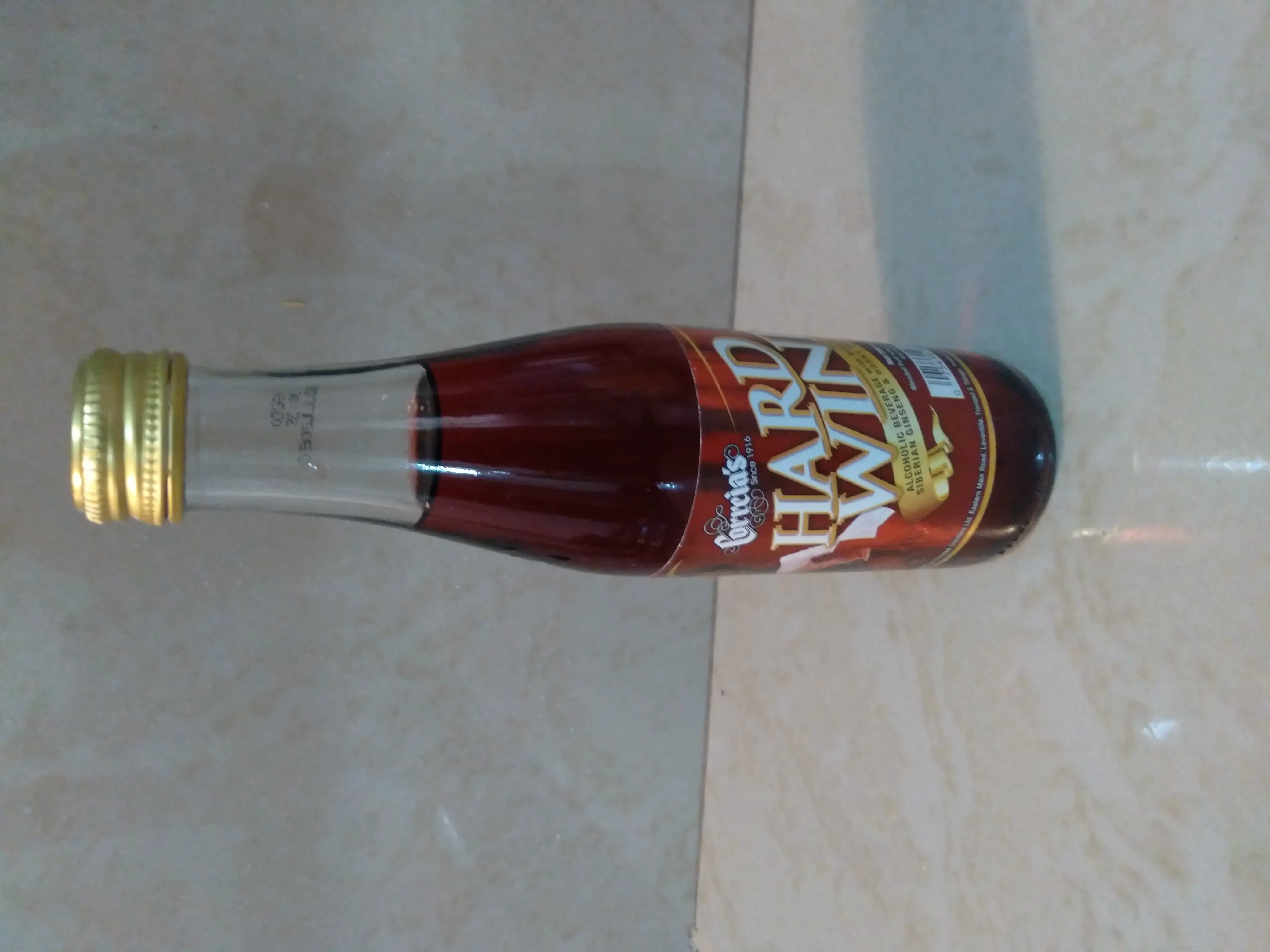
You may use any red wine you like such as a Merlot or Cabernet Sauvignon.
The full quantity of liquid can come from the wine or it can be used as part of the liquid and the lye mixed with water as usual. I opted to use wine as part of the liquid, as you will see below.
As Correia’s Hard Wine in particular is popular with men in my country, the soap could be scented with a masculine fragrance if made for the special man in your life, however, I wanted to experiment with a fruity blend more reminiscent of tropical wine. The fragrances I used were Rose Gold and Pink Mimosa from Bramble Berry and the blend is exactly what I wanted to achieve. I also used micas and titanium dioxide to create a bit of a swirl, but this is totally optional and you can play with any colourants you would like or simply leave the soap as is, as the wine imparts its own colouring.
The resulting soap I got from this recipe was very creamy and bubbly with a silky feel. The soap also had a cooling sensation but that may have been from the specific herbs in the Hard Wine blend.
Alcohol speeds up saponification and can cause overheating when mixed with sodium hydroxide, for this reason, the wine should be boiled for about ten minutes before being used in the soap to remove the alcohol.
Again, I did not use all the liquid as wine in this recipe but incorporated the wine as an additive. If you were to use 100% of your liquid as wine, you would have to freeze the wine, as we do with milk soaps, after boiling off the alcohol. However, I used approximately 1/3 of my liquid as wine which I mixed into the oils and the remaining 2/3 was distilled water that I used to make the lye solution. This I found to be easier, and I did not have any problems with overheating or scorching.
Note, in this method, at least 50% of your lye solution should be water to allow the sodium hydroxide to fully dissolve. If you use less than 50% water, the solution would be too concentrated and some of the crystals would remain solid in the solution, this can cause lye pockets in your soap. So always use at least 50% water and 50% sodium hydroxide when creating the solution.
Remember that some of the wine will evaporate while boiling off the alcohol, so be sure to start with more wine than you need to ensure you have enough for the amount you intend to use in your recipe.
The recipe I created is a small batch using 17 oz of oils that yielded 5 bars, just over 4 oz each after curing.
After running my recipe through a lye calculator for the oils and butters I wanted to use, I got an amount of 6.46 oz of water and 2.38 oz of sodium hydroxide needed at a 5% superfat.
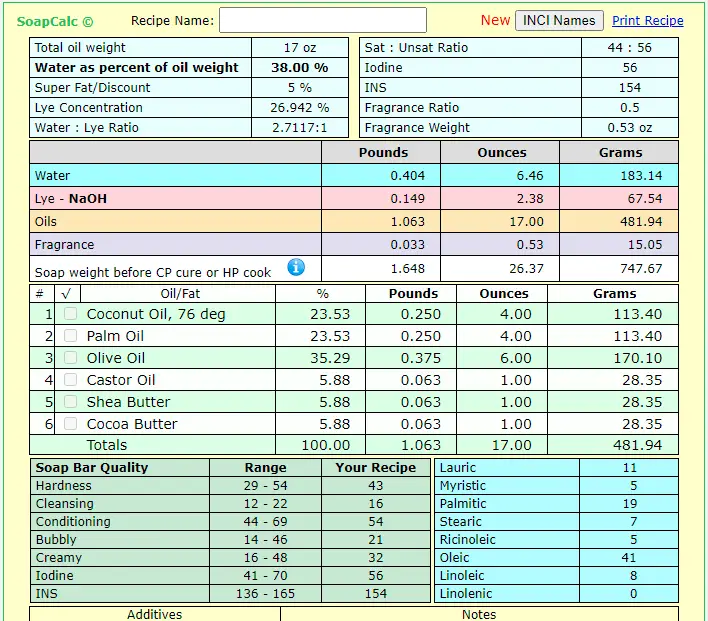
I put approximately 6 oz of wine on a slow simmer for 10 minutes. Allowed it to cool, then placed it in the fridge for about 2 hours. After this, I weighed the wine I wanted for the recipe (2.35 oz) and subtracted it from the total water amount (6.46 oz) to determine the amount of water needed to mix the lye solution (4.11 oz).
Please run your recipe through a lye calculator for the amounts that you would like to use.
How To Make Wine Soap
Ingredients
- 4 oz Coconut oil (23.5%)
- 4 oz Palm oil (23.5%)
- 6 oz Olive oil (35.29%)
- 1 oz Castor oil (5.88%)
- 1 oz Shea Butter (5.88%)
- 1 oz Cocoa butter (5.88%)
- 2.48 oz Sodium Hydroxide
- 4.11 oz Distilled Water
- 2.35 oz Wine (after boiling)
- 0.5 oz Fragrance of your choice
- Micas/pigments or Titanium Dioxide (optional)
Directions
Prepare the wine.
In a pot or saucepan, place the wine and allow it to come to a boil, after which, turn the heat down to low and allow it to simmer for 10 minutes.
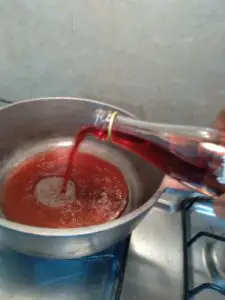
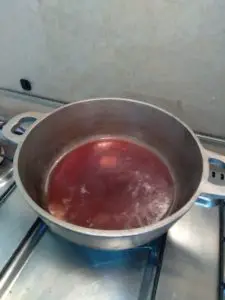
After simmering, allow to cool, then put it in the fridge for about two hours.
Prepare your other ingredients.
As always, when working with caustic lye, suit up for safety. Wear your safety goggles, gloves and long-sleeved clothing. Ensure that there are no children or pets in your production area.
Weigh the distilled water in a heat-proof container then weigh the sodium hydroxide separately.
Mix the lye solution.
In a well-ventilated area add the sodium hydroxide to the water (not the other way around) and stir with a stainless steel spoon to dissolve completely. The solution will become hot and give off fumes, please ensure that you do not inhale the vapours.
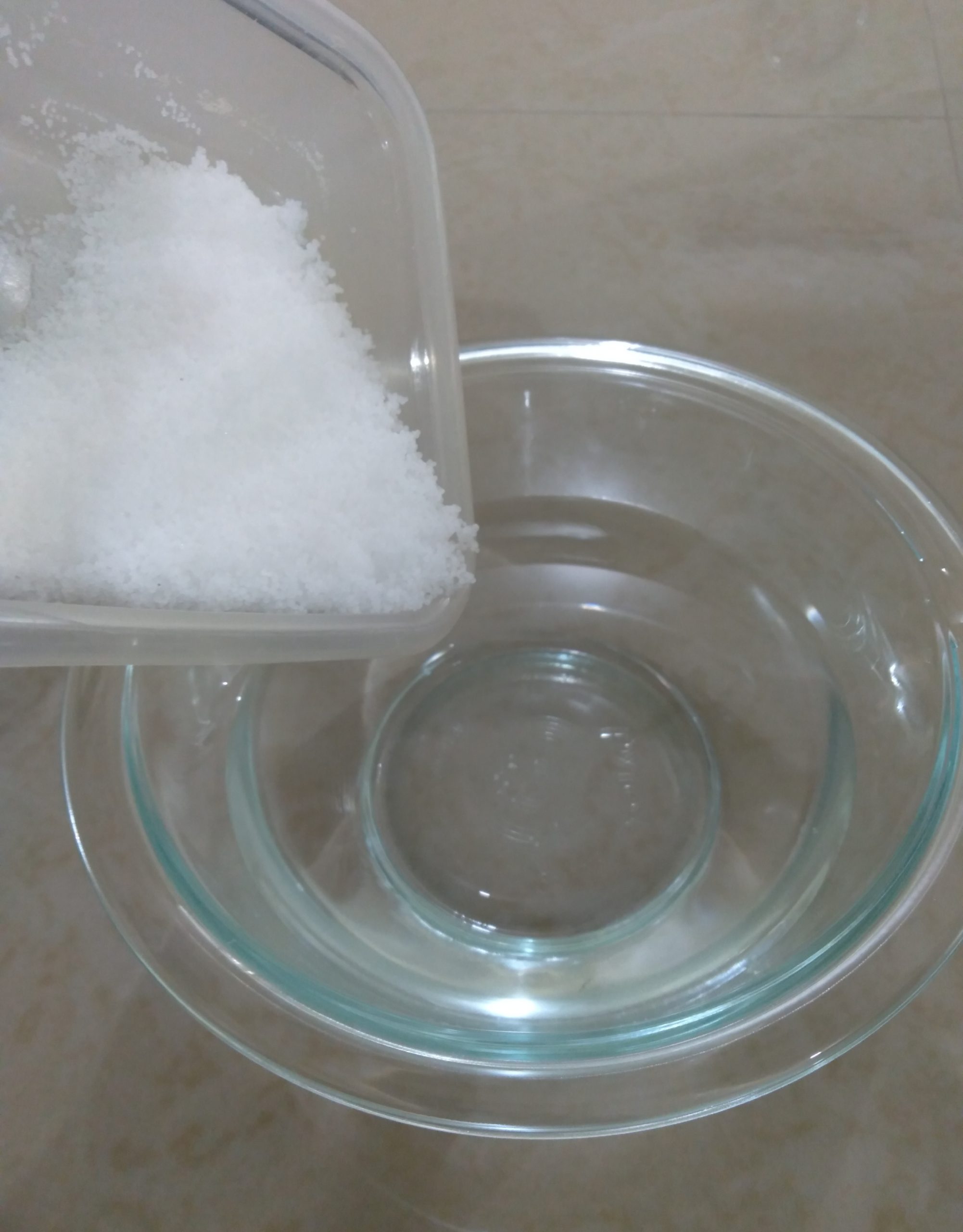
Set aside in a safe area to allow to cool to room temperature or soaping temperature, between 100-130 °F.
Next, weigh out the oils and butters.

In a microwave oven or in a double boiler, melt the butters.
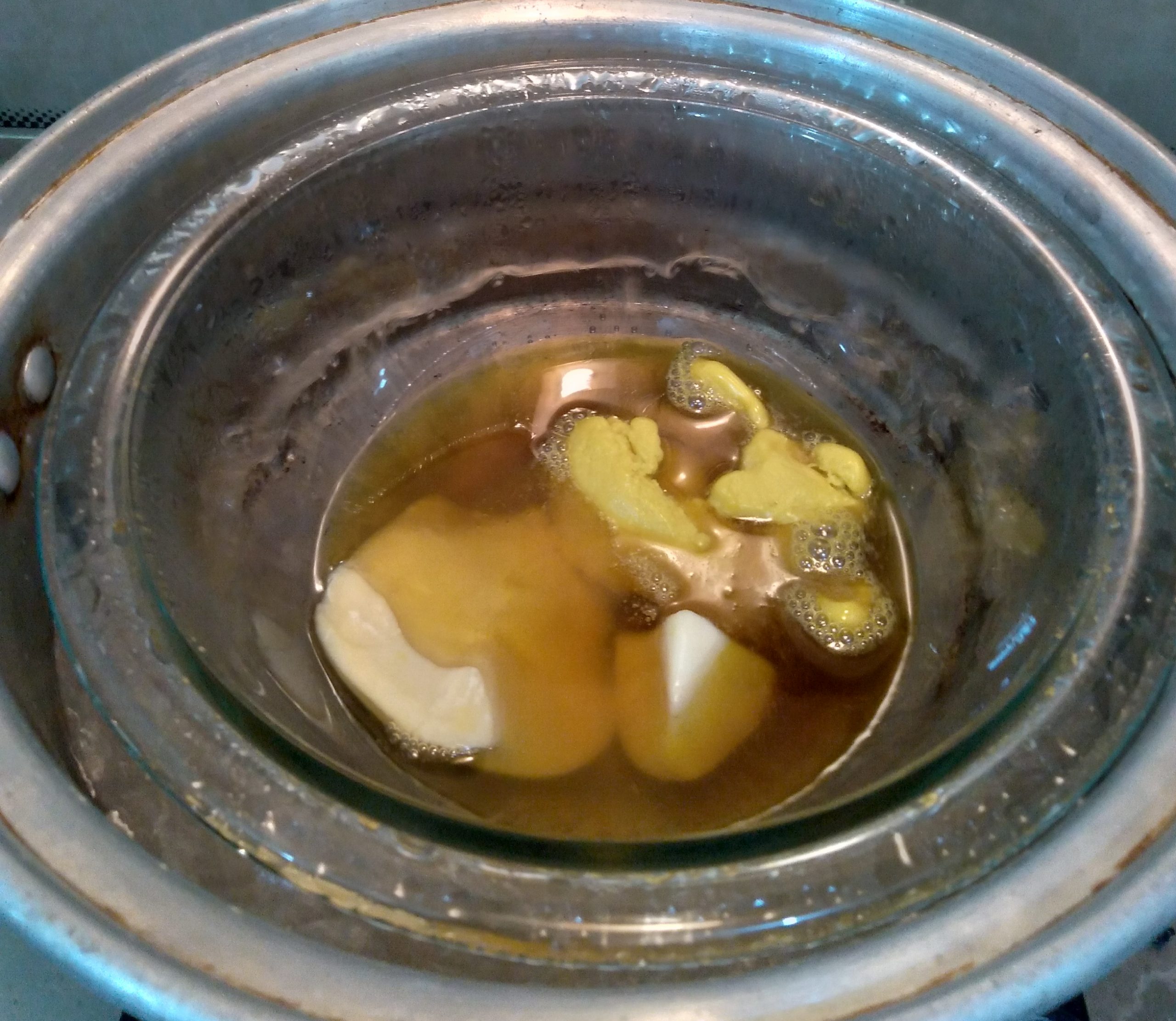
The addition of colourants here is totally optional, but I am including it as an option.
Using a tablespoon of grapeseed oil for each colourant, I prepared separately 1/2 teaspoon Shimmer Gold mica, 1/2 teaspoon Really Red pigment from Nurture Soap, and 1/2 teaspoon Titanium Dioxide.
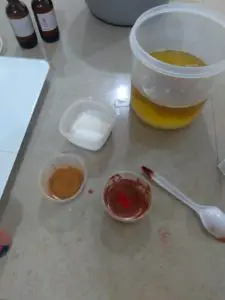
Weigh out the wine.
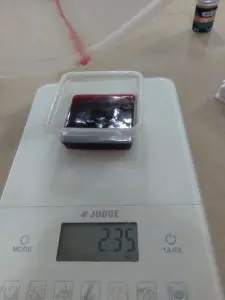
Add the butters to the oil in your mixing container, then add the wine.
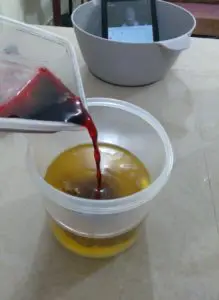
Next, carefully pour the lye solution into the wine/oil mixture and blend with your immersion blender. When emulsion is achieved, add your fragrance and blend at a low speed until you arrive at trace.
If using colourants, blend at low speed to a light trace, then separate the soap into containers and mix the individual colours before swirling. If not using colourants proceed to pour the soap into your mold.
Below is my finished soap, swirled and poured into the mold.
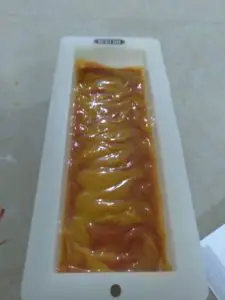
Set the soap aside in a safe space and allow it to harden for 24 hours, after which, take it out of the mold and cut it into bars.
Place your bars in a well-ventilated area and leave them to cure for 4 to 6 weeks before using or gifting to your favourite wine-lover.
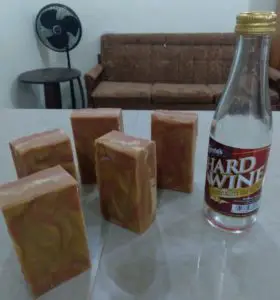

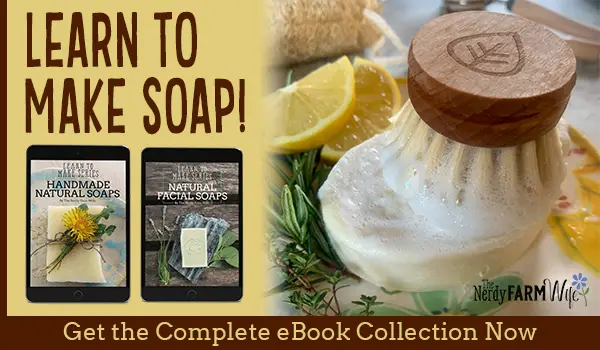
Renée thank you so much for sharing this recipe! I am going to give it a shot and let you know how it comes out!!
Awesome, Candyce! Can hardly wait! 😀